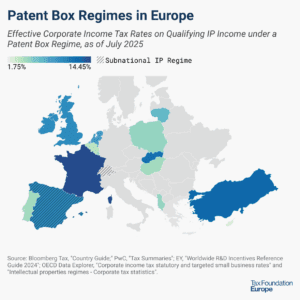
Effects of the Federal Constitutional Court’s Judgment on Germany’s Solidarity Surtax
4 min readBy:On 26 March 2025, Germany’s Federal Constitutional Court upheld the solidarity surtaxA surtax is an additional tax levied on top of an already existing business or individual tax and can have a flat or progressive rate structure. Surtaxes are typically enacted to fund a specific program or initiative, whereas revenue from broader-based taxes, like the individual income tax, typically cover a multitude of programs and services. against a constitutional complaint. This leaves the choice of whether to abolish the surtax to policymakers—a step that would have consequences for the taxA tax is a mandatory payment or charge collected by local, state, and national governments from individuals or businesses to cover the costs of general government services, goods, and activities. rates on personal income, capital gains, dividends, and corporate income. Abolishing the surtax would also make the German income tax system more simple and transparent.
Germany’s Solidarity Surtax Is an International Outlier
Germany’s solidarity surtax was introduced between 1991 and 1992, initially for a limited period in the context of the second Gulf War, and again in 1995 for an indefinite period to finance government spending connected to German reunification. In 2019, the Solidarity Pact II, the final iteration of the transfer programs to rebuild the economy of the new federal states after reunification, expired without replacement. However, the end of this transfer program did not put an end to the surtax that was used to finance it.
The surtax was reformed in 2019 by increasing the tax-free amount to exempt most taxpayers’ labor income starting with the 2021 tax year. Despite the expiration of its original purpose to finance rebuilding the economy of the new federal states after reunification, the solidarity surtax still remains to this day for around 6 million citizens and 500,000 companies, raising €13 billion in revenues for the federal budget.
Today, the solidarity surtax of 5.5 percent, or “Soli” for short, is levied in Germany on all federal corporate tax, capital gains taxA capital gains tax is levied on the profit made from selling an asset and is often in addition to corporate income taxes, frequently resulting in double taxation. These taxes create a bias against saving, leading to a lower level of national income by encouraging present consumption over investment. , and dividend tax liabilities. It is also levied on personal income tax starting at an annual tax liability of €19,950 for single and €39,900 for joint filers. This roughly corresponds to an annual income of €73,500 for single filers and €147,000 for joint filers. If the child allowance or the allowance for care, education, and training is claimed, the solidarity surtax is calculated on the basis of a notional tax liability instead of actual tax liability.
In addition to Germany, only three other countries in the Organisation for Economic Co-operation and Development (OECD)—France, Japan, and Luxembourg—levy a surtax on corporate income. Three other countries—Japan, Korea, and Luxembourg—also levy a surtax on their personal income tax. In addition, several other countries levy other forms of supplementary taxes that are not levied as a surtax.
Surtaxes such as Germany’s solidarity surtax run counter to the principles of simplicity and transparency of the tax system because they impose an additional layer of tax on taxpayers and create a more complex tax structure that often obscures the actual tax burden. The fact that they are levied for a temporary tax purpose, which they often outlive, makes them unpredictable and impairs the stability of the tax system.
Effects of Abolishing the Solidarity Surtax
The abolition of the solidarity surcharge would reduce the combined top personal income tax rate from around 47.5 percent to 45 percent. The combined second-highest tax rate would reduce from 44.31 to 42 percent. Top personal income tax rates that only take effect at high incomes—in Germany, starting at 5.3 times the average income—create higher efficiency losses per euro of revenue generated than marginal tax rates in lower tax bracketsA tax bracket is the range of incomes taxed at given rates, which typically differ depending on filing status. In a progressive individual or corporate income tax system, rates rise as income increases. There are seven federal individual income tax brackets; the federal corporate income tax system is flat. .
Table 1. Personal Income Tax Changes from Abolishing Solidarity Surtax
| Scenario | Top Personal Income Tax Bracket | Second-Highest Personal Income Tax Bracket (a) | Capital Gains and Dividend Tax |
|---|---|---|---|
| Annual Income Thresholds for Single/Joint Filers | €277,826 / €555,652 | €73,500/ €147,000 | €1,000 / €2,000 (savers’ allowance) |
| 2025 Marginal Tax Rate | 47.475% | 44.31% | 26.375% |
| Marginal Tax Rate without Solidarity Surtax | 45% | 42% | 25% |
Source: Einkommensteuergesetz (EStG), § 32a Einkommensteuertarif, https://gesetze-im-internet.de/estg/__32a.html; Bundesministerium der Finanzen, Lohn- und Einkommensteuerrechner, https://bmf-steuerrechner.de/.
Income from capital gains and dividends above the annual tax-free allowance of €1,000 would be taxed at 25 percent instead of the current rate of around 26.4 percent. This brings Germany’s tax rate on capital income closer to the OECD average of 24.7 percent on dividends and 19.7 percent on long-term capital gains. The taxation of pure capital income represents a form of double taxation that reduces long-term saving and investment in favor of immediate consumption.
Table 2. Corporate Income Tax Changes from Abolishing Solidarity Surtax
| Scenario | Federal Corporate Tax Rate | Local Business Tax Rate (a) | Solidarity Surtax | Combined Corporate Tax Rate |
|---|---|---|---|---|
| 2024/25 Tax Rate | 15% | 15.295% | 0.825% | 31.12% |
| Tax Rate without Solidarity Surtax | 15% | 15.295% | 0% | 30.295% |
Source: DIHK, Hebesätze deutscher Städte und Gemeinden 2024, https://dihk.de/de/themen-und-positionen/wirtschaftspolitik/steuer-und-finanzpolitik/hebesaetze-56878.
Companies are subject to a solidarity surtax of 5.5 percent on their liability under the federal corporate tax, which is levied at a rate of 15 percent. The local business tax burden, which accounts for around half of the corporate tax burden and varies by location, remains unaffected. Abolishing the solidarity surtax would reduce the average corporate tax burden by 0.825 percentage points.
This means that even if the solidarity surtax were abolished, Germany would retain the third-highest combined corporate tax rate among the 38 OECD countries, behind Colombia (35 percent) and Portugal (31.5 percent). Significantly aligning Germany’s corporate rate with the OECD average of 23.9 percent would require further action from policymakers.
In summary, abolishing Germany’s solidarity surtax would bring down tax rates on high personal incomes, personal savings, and corporate income, providing €13 billion of tax cuts for more than 6 million citizens and half a million businesses. It would also make the German tax system more simple and transparent, reducing the number of separate income tax bases. Notwithstanding the verdict of the Federal Constitutional Court, the expiration of the spending programs that the solidarity surtax was supposed to fund in 2019 lends support to an abolition in alignment with taxpayers’ expectations and restoring income taxation to standard tax schedules.
Share this article




